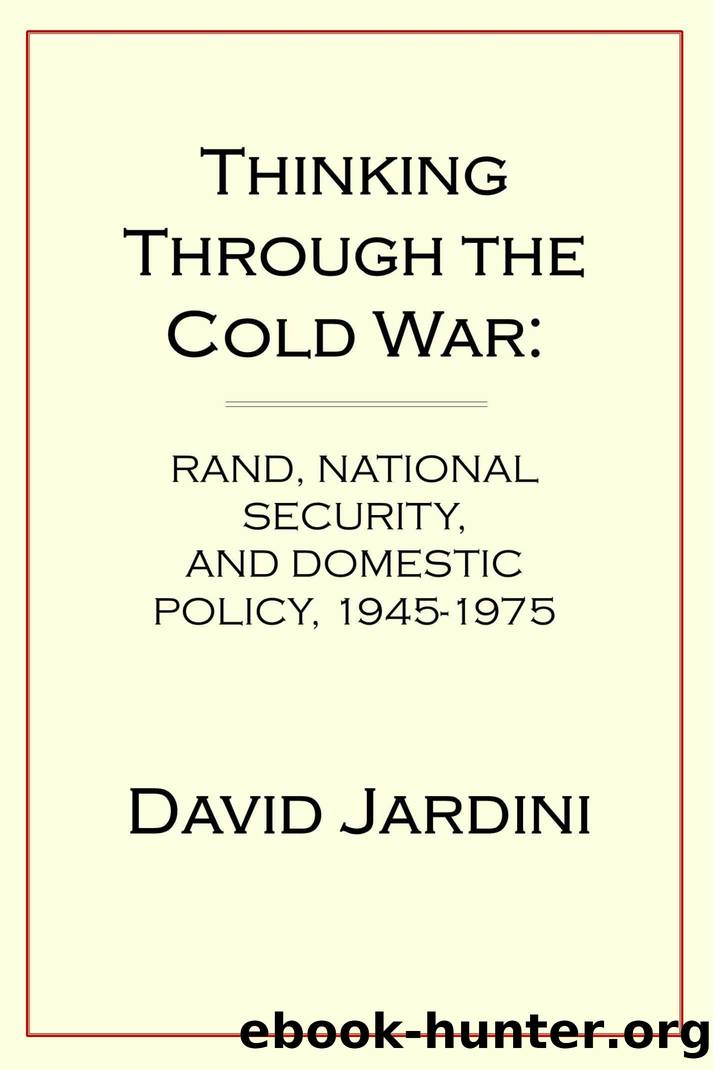Thinking Through the Cold War by David Jardini

Author:David Jardini
Language: eng
Format: azw3
Published: 2013-08-29T21:00:00+00:00
the systematic examination and comparison of alternative future sources of action in terms of their expected costs, benefits and risks. While quantitative methods of analysis are used as much as possible, qualitative analysis must often be used to supplement the quantitative work. The main purpose of system analysis is to provide information to decision-makers that will sharpen their intuition and judgment and hopefully provide the basis for more informed choices.[850]
Upon his return to RAND, Rowen believed that the corporation’s most valuable asset in its diversification would be its experience and expertise in applying systems analysis to complex problems. However, systems analysis—as well as RAND’s practice of systems analysis—would have to be transformed to cope with the peculiar problems involved in social policy research. Paul Armer[851], a member of the “Future Work Team” that was laying the groundwork for diversification when Rowen arrived, commented, “It is important to realize that we have spent many years in the national security area understanding the basic issues and parameters of the problem. We do not have this basic understanding in the new areas to which we may take the tools we have developed, and consequently we must anticipate that these tools may not serve us as well immediately. . . .”[852]
The application of systems analysis to non-military problems posed a series of difficult challenges; to meet these challenges RAND had to re-engineer and re-deploy systems analysis itself.[853] First, social welfare issues are more often characterized by an interrelationship of problems, especially situations in which the solution of one problem might be the cause of another, than is the case in defense analyses. For example, satisfactory school integration policies can not be developed without careful study of housing patterns and possibilities. Thus RAND’s social systems analysts had to define the boundaries of their analyses according to logical criteria rather than such traditional social conventions as political jurisdictions and academic disciplines.
Second, systems analyses of social policy issues have to confront a wider range of potential solutions—legislative and technical, public and private, local and national—than is the case in national security analysis. Furthermore, Americans’ cultural bias towards technical solutions to public policy problems, whether in the defense of social welfare arena, often constrained adequate consideration of policy choices aimed at changing underlying institutions or behaviors. RAND’s social systems analysts would have to be conscious of this bias and be willing to identify and evaluate non-technological solutions to social problems. This would prove difficult at RAND where technically proficient scholars pervaded analytical efforts.
A reevaluation of the “criteria problem” that had plagued RAND’s early national defense analyses was a third consideration in adapting systems analysis to social welfare problems. The performance of meaningful cost-benefit analyses in the social welfare sectors entails careful measurement of costs and the recognition that the social costs of a given policy choice might take many forms. These include dollar costs to individuals or organizations as well as more subtle costs, such as discomfort, conflict, or sickness, that can be assigned only uncertain monetary values.
Download
This site does not store any files on its server. We only index and link to content provided by other sites. Please contact the content providers to delete copyright contents if any and email us, we'll remove relevant links or contents immediately.
| Anthropology | Archaeology |
| Philosophy | Politics & Government |
| Social Sciences | Sociology |
| Women's Studies |
Cecilia; Or, Memoirs of an Heiress — Volume 1 by Fanny Burney(31321)
Cecilia; Or, Memoirs of an Heiress — Volume 3 by Fanny Burney(30928)
Cecilia; Or, Memoirs of an Heiress — Volume 2 by Fanny Burney(30884)
The Great Music City by Andrea Baker(21166)
We're Going to Need More Wine by Gabrielle Union(18064)
Bombshells: Glamour Girls of a Lifetime by Sullivan Steve(13100)
Pimp by Iceberg Slim(12922)
All the Missing Girls by Megan Miranda(12739)
Fifty Shades Freed by E L James(12443)
Norse Mythology by Gaiman Neil(11873)
Talking to Strangers by Malcolm Gladwell(11859)
Crazy Rich Asians by Kevin Kwan(8340)
Mindhunter: Inside the FBI's Elite Serial Crime Unit by John E. Douglas & Mark Olshaker(7827)
The Lost Art of Listening by Michael P. Nichols(6461)
Enlightenment Now: The Case for Reason, Science, Humanism, and Progress by Steven Pinker(6402)
Bad Blood by John Carreyrou(5760)
The Four Agreements by Don Miguel Ruiz(5502)
Weapons of Math Destruction by Cathy O'Neil(5029)
We Need to Talk by Celeste Headlee(4861)
